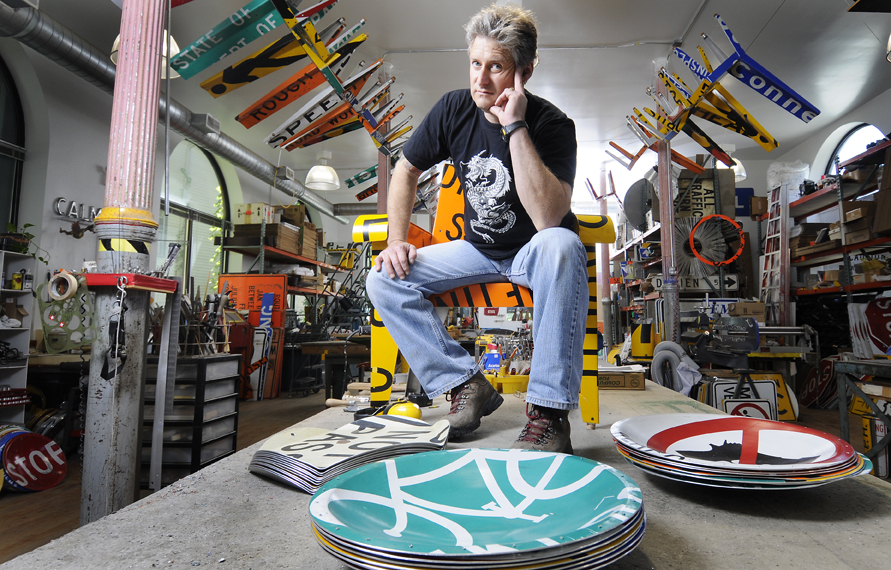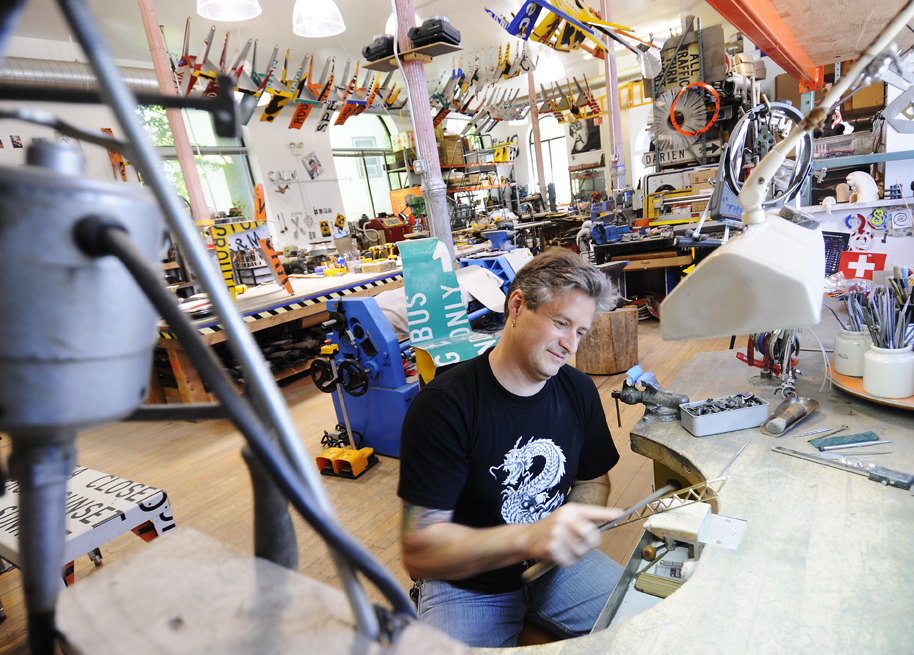Recycling to the point of absurdity: Q&A with Artist Boris Bally
Artist Boris Bally transforms found materials and unwanted traffic signs into stunning and subversive works of art.
At 14, he started making martial arts weapons and skateboards. At 15, he held his first craft show, showcasing sterling silver jewelry. Then came an apprenticeship with a master goldsmith in Switzerland. But Bally’s focus shifted from the precious to the undesirable. “It’s a lot more exciting to make things out of no value rather than out of precious materials, of things that already have intrinsic value,” he says. “For me the challenge was far greater to start with garbage.”
Based in Rhode Island, Bally uses scrap as well as new signs – returned from buyers to the manufacturers, including to RoadTrafficSigns.com. We spoke with Boris about his work, his process, and finding art hidden in the signs.
Katy Olson: Tell us a little bit about what you do.
Boris Bally: Signs tell you what not to do, and I get to cut them up and beat them up and turn them into things they’re not supposed to be with a material you’re not supposed to use! That’s what kind of keeps me giggling each day when I go into the studio.
[With signs such as] legal signs, [words like] slip, spit, and other funny words or icons – I can isolate the image or word and everyone has some connection to the color, word, snippet of the word. I retain the humor of the word.
It’s recycling to the point of absurdity.
KO: What tools and techniques do you use?
BB: My work is “HUMANUFACTURED®.” We make everything by hand using Handbrakes, used for bends in chairs; the spinning process – taking a sign and, while it’s spinning, press it against a wooden form or steel form, done on a [tool called a] lathe; band saws – used for cutting out raw forms and shapes out of signs; jewelry saws and hand files.
To make a chair, we first test the sign to make sure it bends OK. Then we take templates perfected over the years, place them over the sign and trace which parts we want to use for the furniture. We hand-finish them by sanding them and hand filing them, and then we bend them using the handbrake.
The problem often, even though we spend time getting to this point, is that sometimes the signs will snap. That’s when we make key chains or smaller items like coasters with the leftovers! It’s kind of like the Native American who would slay a bison – we use every part of the animal. And nothing leaves the studio that you can’t make into anything else.
KO: What are some of the most interesting or unusual pieces you’ve designed?
BB: One of the coolest things was making a box for someone’s wedding ring. One of the proudest was making installations for various hospitals such as the Cleveland Rainbow Babies Children’s Hospital, because I love the fact that these pieces have universal appeal: they’ll appeal to kids, to an adult, someone in-the-know in the art world.
KO: Who are your customers?
BB: I call them my family, my shareholders. Along with my studio manager Rob Boyd, who “humanufactures” my designs, we are the company, the stocks are the pieces we create and the customers are our shareholders: family, friends, colleagues, museums, collectors, people who buy them through galleries who don’t know who the heck I am, people I swim laps with in the pool, students… There’s no better flattery than someone using the work and living with the work in their home. That’s a special place and what goes there is really important.
Boris Bally’s work can be found in the Victoria & Albert Museum, London; Museum of Art & Design, New York, NY; Brooklyn Museum, Brooklyn, NY; Carnegie Museum of Art, Pittsburgh; PA; Yale University Art Collection. Commissions are available through such online retailers as artful home.
Category: Behind the curtain, Humor Traffic Signs



















